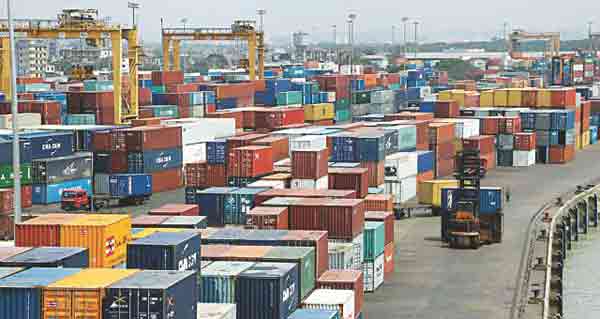

BBN file photo
Dhaka, Bangladesh (BBN)– Bangladesh’s overall trade deficit crossed US$15-billion mark in the first ten months of this fiscal following higher import payments against lower export receipts.
The gap in merchandise trade with the rest of the world rose by 87.54 per cent or $7.16 billion to $15.33 billion in July-April period of FY 2017-18, from $8.18 billion in the same period of the previous fiscal, according to the latest central bank statistics.
Talking to the BBN, a senior official of the Bangladesh Bank (BB), the country’s central bank, said higher import payment obligations, particularly for food grains and fuel oils pushed up the overall trade deficit significantly during the period under review.
The BB data showed that import expenses jumped by 25.18 per cent during the period under review while export earnings recorded nearly 7.0 per cent growth in the same period.
The overall import rose to $45.35 billion in the July-April period of FY18 from $ 26.23 billion in the same period of the previous fiscal.
Experts and senior economists, however, suggested the authorities concerned for taking effective measures to monitor closely for curbing less necessary imports.
They also said there is a need to scrutinise as to whether capital is being flight out from the country in the name of imports. “The import should be rationalized.”
On the other hand, the export earnings stood at over $30 billion in the first ten months of this fiscal against $ 28.05 billion in the same period of the FY17.
The BB official expressed the fear that the overall trade deficit may widen further in the coming months if the falling trend in export earnings continues.
Alone in May 2018, export receipts stood at $ 3.32 billion. The monthly target was, however, missed by 1.70 per cent.
The monthly export target was $ 3.38 billion for the month of May 2018.
However, deficit in service trade also increased to $3.77 billion in the first ten months of FY 18, which was $2.76 billion in the same period of the previous fiscal.
Trade in services includes tourism, financial service and insurance.
Besides, the ongoing higher trade gap put a pressure on the exchange rate, with the Bangladesh Taka (BDT) becoming weaker against the US dollar gradually.
The depreciating mode of BDT continues against the greenback despite of selling the US dollar by the central bank to the commercial banks to keep stable the country’s foreign exchange market.
The central bank so far sold more than $2.0 billion to the commercial banks this fiscal year as part of its ongoing liquidity support for settling import payment obligations particularly for fuel oils, food grains and capital machinery.
But the exchange-rate management is mostly on the right track considering the overall economic activities of Bangladesh, according to the experts.
Though the country has good amount of foreign- exchange reserves, there is little scope to be complacent as pressure on import payments may go mounting further, they added.
They also said the authorities concerned will have to take effective measures immediately to boost export earnings as well as to increase the flow of inward remittance further for improving the current account balance position.
However, the higher trade deficit pushed further up the current-account deficit during the period under review despite an uptrend in inward remittances.
Bangladesh’s current account deficit reached $8.51 billion during the period under review against $1.80 billion in the same period of the last fiscal year. It was $7.09 billion a month ago.
The inflow of remittance, however, increased by 17 per cent to $11.85 billion in the first ten months of FY18 from $10.13 billion in the same period of FY 17.
The central banker said higher inflow of medium- and long-term loans helped maintain a robust surplus in the financial account during the period under review.
The financial account recorded a surplus of $6.89 billion during the July-April period of FY18 despite falling trend of the inflow of foreign direct investment (FDI). It was $3.23 billion in the same period of the previous fiscal.
The volume of FDI decrease slightly during the period under review following lower inflow of foreign investment particularly in telecommunication sector, the central banker explained.
He also expects that the FDI inflow may increase in the coming months if the effective initiatives will be taken by the authorities concerned.
The gross inflow of FDI decreased by 7.35 per cent to $ 2.37 billion during the period under review from $2.56 billion in the same period of FY 17, the BB data showed.
Besides, net FDI inflow drooped by 4.20 per cent to $1.46 billion from $ 1.52 billion.
The soaring gap in trade as well as the current account reflects the growing imbalance of the external account, thus creating mounting pressure on the overall balance of payments (BoP).
Bangladesh’s BoP slid to a deficit of $ 1.04 billion during the period under review, which was surplus of $ 2.30 billion in the same period of FY 17.
The BoP deficit was $ 1.10 billion a month ago.
The BoP deficit was $354 million in July-December period of FY 18. It was $360 million in the first quarter (Q1) of the ongoing fiscal.
The experts also expressed concerned over the ongoing pressures on the external sector, saying that it may hamper overall stability in the country’s financial sector if the same trend continues.
BBN/SSR/AD